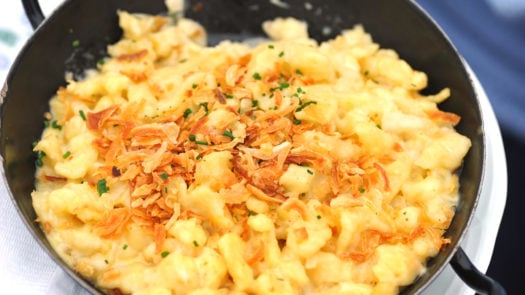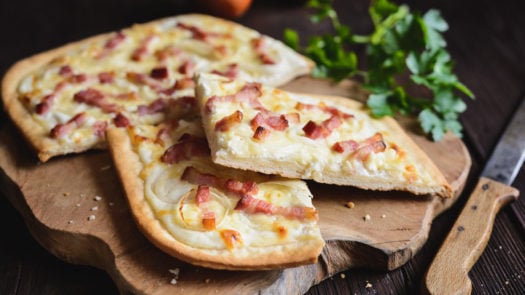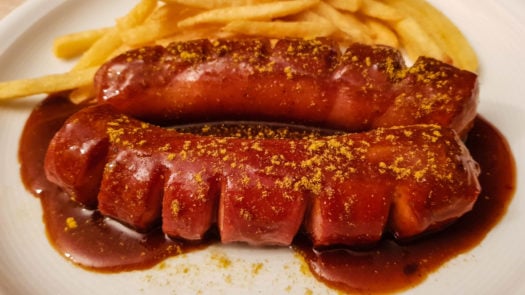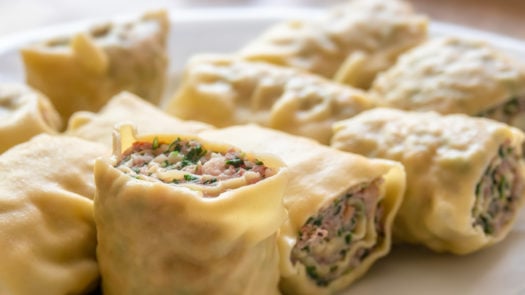Published on: February 17th, 2020
Last modified: December 7th, 2023
From German pasta dishes to over 40 different varieties of sausage, German cuisine is comfort food at its finest.
To help you sink your teeth into the local cuisine, we’ve put together this list of our top 10 must-try dishes in Germany.
1) Spätzle
Germany’s version of pasta, spätzle is made from a simple yet exquisite combination of eggs, flour, salt and a splash of sparkling water. Originating from Baden-Württemberg, this tasty dish is traditionally served as an accompaniment to meat dishes or used to hearten up soups. This simple side dish can be transformed into something mighty with the simple addition of Emmental or Swiss cheese. Often touted as the German macaroni cheese, hot spätzle and grated granular cheese are layered alternately and topped off with fried onions to create Germany’s most popular beer garden foodstuff.

2) Schnitzel
You’d be forgiven for thinking schnitzel is Austrian rather than German, but what you might not know is that this breaded meat dish actually originated in Italy. While the Austrian ‘Wiener Schnitzel’ is by law only made with veal, the German version is made with tenderised pork or turkey, and is a staple of most traditional German restaurants. In Germany, the traditional schnitzel also often comes laden in sauce; options range from Jägerschnitzel (schnitzel in mushroom sauce) to Zigeunerschnitzel, with bell pepper sauce.

3) Flammkuchen
Claimed by both France and Germany, the ever-popular flammkuchen hails from the Alsace region, that in the past has been a dispute between the two countries. A sort of German pizza, flammkuchen is a thinly-rolled, rectangular shaped bread dough traditionally topped with crème fraîche, thinly sliced onions and lardons. Finished by being baked in a wood-fire oven, this delightful delicacy packs a comforting yet delicious salty punch that’ll leave you wanting more.

4) Currywurst
A German perennial, the invention of currywurst is thought to date back as far as 1949. It’s thought that Herta Heuwer – a Berlin resident – came up with the dish after sourcing ketchup and curry powder from British soldiers, which she then served over grilled sausage, giving rise to a German street food classic. Today, currywurst is one of Germany’s most famous sausage-based street-food snacks, and even has an entire museum dedicated to it. With some 800 million currywurst consumed across Germany each year, the best places to have a taste are Berlin, Cologne and the Rhine-Ruhr, where it’s usually served with chips and ketchup or mayonnaise or a bread roll.

5) Sauerkraut
The renowned salty and sour taste of fermented cabbage is a staple across Germany, albeit being somewhat of an acquired taste. Before frozen foods, refrigeration and cheap transport options from warmer climes became readily available across Europe, preserved foodstuffs provided a source of nutrients during the winter months. Today, sauerkraut is enjoyed as an accompaniment to meat dishes, and has the added benefit of being great for gut health.

6) Bratwurst
The humble sausage, or bratwurst as it’s known in Germany, is a cornerstone of German cuisine. There are countless smoked, cured and other varieties of sausage on offer across the country with more than 40 types in total. Some of the more popular varieties include Fränkische bratwurst (from Franconia) with marjoram as a characteristic ingredient and Thüringer rostbratwurst (from Thuringia), which is quite spicy. Thuringia is also the home of the first German bratwurst museum, which opened in 2006. Enjoy Germany’s humble sausages served in a bread roll, with potato salad or alongside a spot of sauerkraut.

7) Königsberger klopse
Named after the former East Prussian capital of Königsberg (now Kaliningrad in Russia), this tasty dish of meatballs in a creamy white sauce with capers is a real crowd pleaser. Traditionally made with onion, eggs, anchovies, pepper and other spices mixed together with veal, these meatballs pack a flavoursome punch. Today, it’s possible to find königsberger klopse in most German restaurants, but they are especially popular in Berlin and Brandenburg.

8) Maultaschen
Essentially a larger version of ravioli, maultaschen are typically palm-sized, square pockets of dough that vary in filling from sweet to savory and meaty to vegetarian. Originally from Swabia, the most common iteration of this pasta dish is a combination of minced meat, bread crumbs, onion and spinach all encased in a delightfully fluffy dough. Across south Germany, these delicious dumplings have become so important that in 2009, the European Union recognized maultaschen as a regional specialty and marked the dish as significant to the cultural heritage of the state of Baden-Württemberg.

9) Rouladen
Popular across western Germany and the Rhine region, rouladen is a delicious blend of bacon, onions, mustard and pickles wrapped together in sliced beef or veal. Vegetarian and other meat options are also now widely available but the real deal is rinderrouladen, the beef variety. Usually served with potato dumplings, mashed potato and pickled red cabbage, these impressive roulades normally constitute the centrepiece of family dinners and special occasions.

10) Beer
This isn’t technically a foodie dish, but we couldn’t write a food guide to Germany without mention of the nation’s favourite beverage. Beer, or bier as the Germans call it, even has its own festival – Oktoberfest runs each September and celebrates all things beer for around two weeks. As the birthplace of lager, most German beers are held to the Reinheitsgebot (the German Beer Purity Law) that originated in the sixteenth century. It specifies that only water, malt and hops could be used to make beers (they didn’t know that yeast made beer ferment in those days), guaranteeing only the freshest of tipples.

Discover Germany's foodie side
Feeling inspired? Our expert travel designers are always on hand to help you plan your next foodie journey through Germany.





